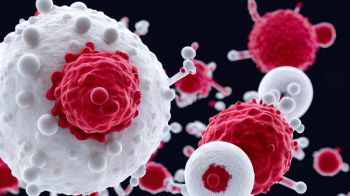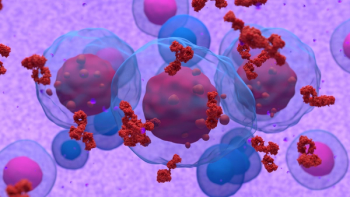
Niraparib Plus Abiraterone Improves rPFS in HRR-Mutated mCSPC
The combination of niraparib with abiraterone acetate and prednisone (AAP) boosted rPFS vs AAP plus placebo in HRR-mutated mCSPC.
Patients with metastatic castration-sensitive prostate cancer (mCSPC) harboring HRR mutations saw a 37% reduction in the risk of death or radiographic progression with the combination of PARP inhibitor niraparib (Akeega) with abiraterone acetate (Zytiga) and prednisone (AAP) vs AAP plus placebo after receiving previous androgen deprivation therapy (ADT), according to data from the phase 3 AMPLITUDE trial (NCT04497844) shared at the
After a median follow-up of 30.8 months, the median radiographic progression-free survival (rPFS) was not estimable in the niraparib group compared with 29.5 months in the placebo arm (HR, 0.63; 95% CI, 0.49-0.80; P = .0001). Furthermore, niraparib plus AAP significantly reduced the risk symptomatic progression by 50% compared with AAP and placebo (HR, 0.50; 95% CI, 0.36-0.69; P <.0001). Overall survival (OS) was not statically significant at the analysis, with trends beginning to emerge showing improvement with niraparib (HR, 0.79; 95% CI, 0.59-1.04; P = .10).
“Improvements in rPFS are supported by a statistically significant benefit in time to symptomatic progression and a trend toward improved OS,” lead investigator Gerhardt Attard, MD, PhD, Cancer Institute, University College London, said during a presentation of the findings. “In my opinion, AMPLITUDE supports niraparib plus AAP as a treatment option for patients in this poor prognostic disease group.”
Analyzing Patient Demographics and Additional Findings From AMPLITUDE
In the study, 696 patients were evenly randomized to receive niraparib plus AAP (n = 348) or placebo plus AAP (n = 348). The median age of enrolled patients was 68 years. Overall, 78% of patients had high-volume metastatic disease (M1), of which 87% were de novo M1. All patients had received ADT for 6 months or less and 16% of patients had received prior docetaxel. All patients in the study had an alteration in genes associated with HRR, which included BRCA1/2 alterations for 55.6% of patients. Remaining alterations could have been in BRIP1, CDK12, CHEK2, FANCA, PALB2, RAD51B, or RAD54L.
For patients specifically with BRCA mutations, the improvements in rPFS were more pronounced. In this group, there was a 48% reduction in the risk of radiographic progression or death with the addition of the PARP inhibitor. The median for the niraparib arm was not estimable compared with 26.0 months with AAP (HR, 0.52; 95% CI, 0.37-0.72; P <.0001).
“This was a really exciting result,” said Attard. “This is the first study to show efficacy for PARP inhibition and androgen receptor inhibition in CSPC, the benefit [of which] might be greatest in patients with BRCA mutations.”
Those with BRCA1/2 mutations also had a significant reduction in the risk of symptomatic progression. In this subgroup, there was a 56% reduction in the risk of symptom progression with the PARP inhibitor compared with the androgen synthesis inhibitor and placebo (HR, 0.44; 95% CI, 0.29-0.68; P = .0001).
“This is a patient-centric end point, measuring the time to worsening of symptoms, which includes needing radiation or a procedure or intervention or further cancer treatment,” said Attard. “Very convincingly we show a clear benefit with niraparib.”
OS was still immature across the study. At the analysis, the BRCA1/2 subgroup showed similar trends as in the full population of those with HRR gene alterations. In this group, there was an early 25% reduction in the risk of death observed with niraparib (HR, 0.75; 95% CI, 0.51-1.11; P = .15).
“Half the number of patients have died from the target number we would require for the final analysis, but in my view, there’s a clear trend for favoring survival in the patients randomized to niraparib,” said Attard.
Zeroing in on Safety and Possible Implications
Grade 3 or 4 adverse effects (AEs) were observed in 75.2% of those receiving niraparib compared with 58.9% of those in the control arm. The most common AEs were anemia (29.1% with niraparib vs 4.6% with placebo) and hypertension (26.5% vs 18.4%). Of those with anemia, the majority required a transfusion.
Dose interruptions were required for 66.9% of patients in the niraparib arm compared with 42.4% for the control arm. Dose reductions were needed to address AEs for 21.9% of those in the niraparib arm compared with 6.9% of those in the placebo group. Treatment was discontinued for 14.7% of those in the niraparib arm compared with 10.3% of those in the placebo group. Treatment-emergent AEs led to death for 14 patients in the investigational arm compared with 7 in the control group.
“We’re used to the side effect profile with these drugs, and we aren’t seeing any new side effects but clearly those randomized to niraparib have more AEs than those randomized to placebo,” said Attard. “But critically, I think, the proportion of patients who [were] required to discontinue treatment was fewer than 5% for those on niraparib vs placebo.”
In 2023, niraparib was approved by the FDA in combination with AAP for patients with deleterious or suspected deleterious BRCA-mutated castration-resistant prostate cancer, based on findings from the phase 3 MAGNITUDE study (NCT03748641).3 Results from the AMPLITUDE study could expand this approval to those with castration-sensitive disease.1
“This is really exciting news for our patients,” ASCO expert commentator
Bradley McGregor, MD, from Dana-Farber Cancer Institute, said of the results. “PARP inhibitors have been a mainstay in the treatment of metastatic castrate-resistant prostate cancer for those patients with HRR alterations, and this is the first time we’ve seen data for these in the hormone-sensitive setting. As you heard this is a very poor prognostic group, so I think this is incredibly exciting.”
References
- Attard G, Agarwal N, Graff J, et al. Phase 3 AMPLITUDE trial: niraparib (NIRA) and abiraterone acetate plus prednisone (AAP) for metastatic castration-sensitive prostate cancer (mCSPC) patients (pts) with alterations in homologous recombination repair (HRR) genes. J Clin Oncol. 2025;43 (suppl 17):LBA5006. doi:10.1200/JCO.2025.43.17_suppl.LBA5006
- Adding niraparib to standard treatment may slow cancer growth for some patients with metastatic castration-sensitive prostate cancer. News release. ASCO. June 3, 2025. Accessed June 3, 2025.
- FDA approves niraparib and abiraterone acetate plus prednisone for BRCA-mutated metastatic castration-resistant prostate cancer. FDA. August 11, 2023. Accessed June 2, 2025. https://www.fda.gov/drugs/resources-information-approved-drugs/fda-approves-niraparib-and-abiraterone-acetate-plus-prednisone-brca-mutated-metastatic-castration
Newsletter
Knowledge is power. Don’t miss the most recent breakthroughs in cancer care.
















































































